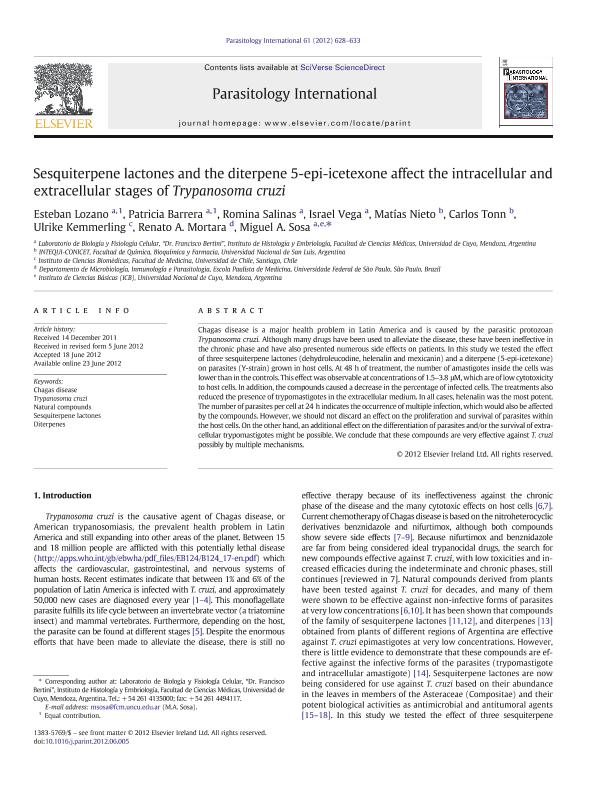Mostrar el registro sencillo del ítem
dc.contributor.author
Lozano, Esteban Sebastián

dc.contributor.author
Barrera, Patricia Andrea

dc.contributor.author
Salinas Ojeda, Romina Paola

dc.contributor.author
Vega, Israel Aníbal

dc.contributor.author
Nieto, Matias Pedro

dc.contributor.author
Tonn, Carlos Eugenio

dc.contributor.author
Kemmerling, Ulrike

dc.contributor.author
Mortara, Renato A.
dc.contributor.author
Sosa Escudero, Miguel Angel

dc.date.available
2021-11-30T02:46:52Z
dc.date.issued
2012-12
dc.identifier.citation
Lozano, Esteban Sebastián; Barrera, Patricia Andrea; Salinas Ojeda, Romina Paola; Vega, Israel Aníbal; Nieto, Matias Pedro; et al.; Sesquiterpene lactones and the diterpene 5-epi-icetexone affect the intracellular and extracellular stages of Trypanosoma cruzi; Elsevier Ireland; Parasitology International; 61; 4; 12-2012; 628-633
dc.identifier.issn
1383-5769
dc.identifier.uri
http://hdl.handle.net/11336/147644
dc.description.abstract
Chagas disease is a major health problem in Latin America and is caused by the parasitic protozoan Trypanosoma cruzi. Although many drugs have been used to alleviate the disease, these have been ineffective in the chronic phase and have also presented numerous side effects on patients. In this study we tested the effect of three sesquiterpene lactones (dehydroleucodine, helenalin and mexicanin) and a diterpene (5-epi-icetexone) on parasites (Y-strain) grown in host cells. At 48. h of treatment, the number of amastigotes inside the cells was lower than in the controls. This effect was observable at concentrations of 1.5-3.8. μM, which are of low cytotoxicity to host cells. In addition, the compounds caused a decrease in the percentage of infected cells. The treatments also reduced the presence of trypomastigotes in the extracellular medium. In all cases, helenalin was the most potent. The number of parasites per cell at 24. h indicates the occurrence of multiple infection, which would also be affected by the compounds. However, we should not discard an effect on the proliferation and survival of parasites within the host cells. On the other hand, an additional effect on the differentiation of parasites and/or the survival of extracellular trypomastigotes might be possible. We conclude that these compounds are very effective against T. cruzi possibly by multiple mechanisms. © 2012 Elsevier Ireland Ltd.
dc.format
application/pdf
dc.language.iso
eng
dc.publisher
Elsevier Ireland

dc.rights
info:eu-repo/semantics/openAccess
dc.rights.uri
https://creativecommons.org/licenses/by-nc-sa/2.5/ar/
dc.subject
CHAGAS DISEASE
dc.subject
DITERPENES
dc.subject
NATURAL COMPOUNDS
dc.subject
SESQUITERPENE LACTONES
dc.subject
TRYPANOSOMA CRUZI
dc.subject.classification
Biología Celular, Microbiología

dc.subject.classification
Ciencias Biológicas

dc.subject.classification
CIENCIAS NATURALES Y EXACTAS

dc.title
Sesquiterpene lactones and the diterpene 5-epi-icetexone affect the intracellular and extracellular stages of Trypanosoma cruzi
dc.type
info:eu-repo/semantics/article
dc.type
info:ar-repo/semantics/artículo
dc.type
info:eu-repo/semantics/publishedVersion
dc.date.updated
2021-04-28T20:13:58Z
dc.journal.volume
61
dc.journal.number
4
dc.journal.pagination
628-633
dc.journal.pais
Irlanda

dc.journal.ciudad
Amsterdam
dc.description.fil
Fil: Lozano, Esteban Sebastián. Consejo Nacional de Investigaciones Científicas y Técnicas. Centro Científico Tecnológico Conicet - Mendoza. Instituto de Histología y Embriología de Mendoza Dr. Mario H. Burgos. Universidad Nacional de Cuyo. Facultad de Ciencias Médicas. Instituto de Histología y Embriología de Mendoza Dr. Mario H. Burgos; Argentina
dc.description.fil
Fil: Barrera, Patricia Andrea. Consejo Nacional de Investigaciones Científicas y Técnicas. Centro Científico Tecnológico Conicet - Mendoza. Instituto de Histología y Embriología de Mendoza Dr. Mario H. Burgos. Universidad Nacional de Cuyo. Facultad de Ciencias Médicas. Instituto de Histología y Embriología de Mendoza Dr. Mario H. Burgos; Argentina
dc.description.fil
Fil: Salinas Ojeda, Romina Paola. Consejo Nacional de Investigaciones Científicas y Técnicas. Centro Científico Tecnológico Conicet - Mendoza. Instituto de Histología y Embriología de Mendoza Dr. Mario H. Burgos. Universidad Nacional de Cuyo. Facultad de Ciencias Médicas. Instituto de Histología y Embriología de Mendoza Dr. Mario H. Burgos; Argentina
dc.description.fil
Fil: Vega, Israel Aníbal. Consejo Nacional de Investigaciones Científicas y Técnicas. Centro Científico Tecnológico Conicet - Mendoza. Instituto de Histología y Embriología de Mendoza Dr. Mario H. Burgos. Universidad Nacional de Cuyo. Facultad de Ciencias Médicas. Instituto de Histología y Embriología de Mendoza Dr. Mario H. Burgos; Argentina
dc.description.fil
Fil: Nieto, Matias Pedro. Consejo Nacional de Investigaciones Científicas y Técnicas. Centro Científico Tecnológico Conicet - San Luis. Instituto de Investigaciones en Tecnología Química. Universidad Nacional de San Luis. Facultad de Química, Bioquímica y Farmacia. Instituto de Investigaciones en Tecnología Química; Argentina
dc.description.fil
Fil: Tonn, Carlos Eugenio. Consejo Nacional de Investigaciones Científicas y Técnicas. Centro Científico Tecnológico Conicet - San Luis. Instituto de Investigaciones en Tecnología Química. Universidad Nacional de San Luis. Facultad de Química, Bioquímica y Farmacia. Instituto de Investigaciones en Tecnología Química; Argentina
dc.description.fil
Fil: Kemmerling, Ulrike. Universidad de Chile; Chile
dc.description.fil
Fil: Mortara, Renato A.. Universidade Federal de Sao Paulo; Brasil
dc.description.fil
Fil: Sosa Escudero, Miguel Angel. Consejo Nacional de Investigaciones Científicas y Técnicas. Centro Científico Tecnológico Conicet - Mendoza. Instituto de Histología y Embriología de Mendoza Dr. Mario H. Burgos. Universidad Nacional de Cuyo. Facultad de Ciencias Médicas. Instituto de Histología y Embriología de Mendoza Dr. Mario H. Burgos; Argentina
dc.journal.title
Parasitology International

dc.relation.alternativeid
info:eu-repo/semantics/altIdentifier/doi/http://dx.doi.org/10.1016/j.parint.2012.06.005
dc.relation.alternativeid
info:eu-repo/semantics/altIdentifier/url/https://www.sciencedirect.com/science/article/abs/pii/S1383576912000906
Archivos asociados
